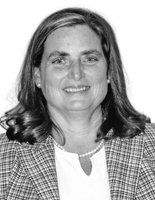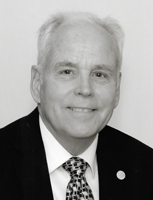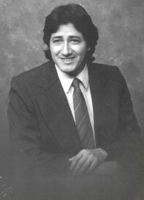 |
||
 |
 |
 |
Judith Hens Academy of the Sacred Heart |
Don Hudson Battle Creek Springfield/B.C. Central |
J.R. Muniz Cabrini |
(click on Inductee's name to read 'description')
 |
||
 |
 |
 |
Judith Hens Academy of the Sacred Heart |
Don Hudson Battle Creek Springfield/B.C. Central |
J.R. Muniz Cabrini |
(click on Inductee's name to read 'description')

 Judith Hens, Academy of the Sacred Heart High School
Judith Hens, Academy of the Sacred Heart High SchoolJudy Hehs grew up just a few blocks from where she currently lives in Birmingham. She got into tennis because it was one of those activities which all kids in the area played. She started at the Beverly Hills Racquet club where she was taught by Keith Cullen (2001 MHSTeCA Coach of the Year from Birmingham Seaholm) and Tighe Keating. “My mom used to go out and hit with me,” she says. “Actually play sets. I remember the day that she called it quits, at least against me. It was the day that I finally beat her. She laid down on the courts at Seaholm and that may have been the last time she played me competitively.”
Judy went on to compete for Julie McKnight (Hall of Fame Class of 1999) at Marian. Although she played her sophomore and junior years, the team was so strong that she didn’t make the varsity squad her senior year. It is a testament to her loyalty and enthusiasm that she stayed on as the team’s manager. A vivid memory was going with a squad loaded with seniors to the state tournament at Stowe Stadium. “It was a high energy weekend,” she says. She would return to Kalamazoo many times in the future but in different capacities.
That trip might also have been a reason why Judy went to Kalamazoo College. “I had played field hockey in the fall and basketball in the winter at K,” she says. “I had no intention of playing tennis at K. Heck, the basketball team had a 50-game losing streak. Compare that to the successes of the tennis programs.”
“I fell into tennis in college,” she continues. I played for Tish Loveless. She was the field hockey coach, so showing up for tennis try-outs wasn’t intimidating. A former teammate from Marian came to get me from my dorm room the afternoon of try-outs and said that clearly I should play tennis. She was right. It was a great decision.”
By the time that the Hornets reached the MIAA Tournament that spring, Judy was playing one doubles with the one singles player. “I was really inspired to continue playing after that experience,” she says. “I played all four years at K.”
Even though field hockey was Judy’s main sport (she played a year in Germany on the National Travel team), she was invited by one of George Acker’s former tennis players to stop by and visit him at Centaur Racquet Club in West Bloomfield. “Before I knew it, I was enlisted to teach ‘tots,’” she says.
That grew exponentially to the point where she had a regular, part-time job at Centaur and then at Franklin Racquet Club. She then got into high school coaching beginning as the JV boys coach at Detroit Country Day.
A chemistry major, Judy was hired to teach physics at Sacred Heart Academy at about the same time. She spent six years teaching in the science department and coaching basketball before “coming to my senses.”
The results are more than impressive. Since becoming varsity tennis coach at Sacred Heart, the Gazelles have won nine regional championships and finished second six times. They have recorded 11 Top Ten finishes in state competition, not the least of which were two state titles, in 2012 and again in 2013. Judy has been regional coach of the year 4 times and was state coach of the year in 2001. Not surprisingly, she is a member of the Catholic High School League Hall of Fame.
Also not surprisingly, Judy’s activities are not limited to collecting trophies and awards. She has been the tournament director of the Division 1 Catholic High School League Tournament since 2004. She has hosted the Gazelle Invitational since 2000. Almost every August, she returns to Kalamazoo to help out the USTA Boys 16 and 18 Nationals, either on the Maintenance Crew, as Score Keeper, or as a volunteer in the Pro Shop. She has served on the MHSAA Rules Committee and is on the MHSTeCA board.
Having spent six years as Dean of Students, Judy is now in her 15th year as the Upper School Director (principal) and sixth as the Associate Head of School. “Her devotion to her teams, to the tennis world in general, and to her school is unquestioned,” says Chuck Wright of Grosse Pte. University Liggett. “She has built a very strong program at ASH during the last 25 years with class and dignity.”| Back to Top |
 Don Hudson , Battle Creek Springfield/B.C. Central High Schools
Don Hudson , Battle Creek Springfield/B.C. Central High Schools“I am probably single-handedly responsible for getting most of my area coaching peers into the Hall of Fame by providing more direct wins for their teams,” chuckles Don Hudson.
Such self-deprecation is undoubtedly appreciated by his colleagues and probably typical of Don’s personality but, to be sure, it is also misleading. Just ask Chris Clark, Bronson Goodsell, Kelly and Meaghan Clark, Katherine Garcia, and Janelle and Ashley Gradwell, names you will find on all conference and all state lists.
But these are only a few names that could be counted among the multitudes whom Don has coached for over 40 years at Battle Creek Springfield and later, at Battle Creek Central. His teams averaged close to 40 kids a year. It’s easy to do the math. But “Longevity is nothing compared to the memories you have with good kids and good parents,” says Don.
To be sure, 40 years is not to be sneezed at, especially the 20 spent at Battle Creek Central. “It’s very important to any program – stability,” says Battle Creek Lakeview’s Mike McGinnis who is referencing the Central years. “If you are constantly changing coaches, it just adds to that instability. To anchor that program for so many years is a credit to him. A lot of coaches -- with not getting as many W’s which keep you going -- quit. To go through some tough times and to not abandon ship says something.”
As a student at Springfield High School, Don joined the tennis team in fledgling status as a doubles player (a highlight was playing the regional tournament in Stowe Stadium at the end of his senior year). This gave him a bit more of a background than his mentor-to-be Jim Cummins (H of F 1990; DSA, 2014), who himself was a converted baseball player. “I never encountered a more voracious competitor and a true student of the game,” says Don. Jim had started the Springfield tennis program with Don as his assistant.
Both Jim and Don were coaches of other sports before leading high school tennis players. Don helped Jim coach the boys in 1974. In 1976, Jim quit coaching football to start the girls program at the school but Don didn’t help out because he still was coaching football in the fall. However, when Jim ceased coaching girls to watch his sons play sports, Don took over the girls. Together the two continued to coach the boys until the school closed. Don then became Battle Creek Central’s varsity coach. A bit later – going full circle -- Jim joined him for six years as an assistant for the girls team.
“If you are looking for negatives (regarding Don), you won’t find any,” says Jim. Perhaps this is to be expected about an individual who not only coached football and wrestling (the latter for 30 years) but was a third grade teacher for 27 (He likes to say that “third grade was the best 28 years of my life”). He then became an elementary physical education teacher for the next 17. A Battle Creek Enquirer article called him BCC’s Dean of Coaches, emphasizing his great relationship with kids.
Allegan’s Gary Ellis notes that there was some question as to whether Battle Creek Central would have continued supporting tennis if not for Don’s presence. “He did a good job holding things together and giving kids there a good opportunity to experience our sport,” he says. “During that time, I suspect without him being there and working with many kids who really didn’t have much experience, it would have been gone. And you know how it is: once something is cut, it is very difficult to get it back.”
And the man can’t quit. Because he retired from teaching, something in the Battle Creek contract wouldn’t allow him to continue coaching there, so Don took his talents, experience, and good will to Harper Creek where he still serves. “I know that Harper Creek has benefited from him being there,” says Gary. “They have had good teams in the past, then really dropped off. The last couple of years they’ve started moving in the right direction. I’m sure that Don has had a hand in that.”
In addition, Don is always available to help at regional and conference tournaments. When Jim manages a state final tournament (which is always), Don is there as a site director. The two also work at the USTA 16 and 18 Nationals each August. The pair have won their fair share of City Tournament doubles titles.
“Don is a low-key person who is much more comfortable out of the spotlight,” concludes Gary. “He has a settling personality and does a good job defusing situations when temperatures rise. The things that he has done for kids and for high school tennis in the Battle Creek area are deserving of being in the spotlight.”
| Back to Top |
 J.R. Muniz , Cabrini High Schooll
J.R. Muniz , Cabrini High Schooll“Starting as a tennis team member was the furthest thing from my mind as a 9th grader at Ecorse High School until my Algebra teacher convinced me to act as a team manager,” wrote J.R. Muniz in 2013. “All I had to do was hand out towels and clean up the locker room.”
As it turns out, that Algebra teacher was Hall of Fame tennis coach John Ghindia (Class of 1994). “A few weeks later, he put a racket in my hand to play an exhibition match,” continued J.R. “That was it. I was hooked on the game of tennis from that day forward.”
J.R. was also fortunate to rub shoulders with another Hall of Famer, the legendary Jean Hoxie. “Our league included Hamtramck,” he wrote. “I remember her comments as being more than encouraging. Coach Hoxie started calling me ‘Bright Eyes’. She complimented me on my play. She had a knack for saying something at the right time, in the right tone, and made you feel like the center of attention.”
A walk-on at Wayne State University, J.R. played varsity tennis for four years on teams that captured four consecutive GLIAC championships. He was doubles MVP his senior season. He then proceeded to “pass it on” as the head coach at Riverview Gabriel Richard, the head coach at Allen Park Cabrini after Hall of Famer Al Kaye retired , as a volunteer assistant to Hall of Famer Jan Gottlin at Riverview Community, and as a volunteer assistant at his alma mater back in 1982. He even tried to resurrect the tennis program at Ecorse High School in 2009, directing a co-ed team which competed in scrimmage matches with area schools. At the time, MHSTeCA board members remember J.R. asking for spare rackets.
There were, of course, plenty of wins but most memorable about J.R. was the inspiration with which he went about his business. “He got me fired up to watch his kids,” said one opposing coach back in 2002 when J.R. was voted state coach of the year. “He was a charismatic motivator.”
This did not go unrecognized. J.R. was the News Herald’s All Area Coach of the Year five times. He was the Catholic High School League Division II Coach of the Year in 1999, 2000, 2001, 2003, 2006, and 2007. He was also a MHSTeCA board member.
“There is nothing like seeing a kid experience success,” J.R. once said. “Smiles are worth millions.” He supplied plenty of them, not only in the fall and spring seasons but also in the summers: 12 years as director of the summer tennis program for Southgate Recreation where high school players were offered match play experience twice a week at no cost. The program grew into the largest of its kind in the Downriver area. He also served as director of tennis for the Ecorse Recreation Department in the early days. He hosted the Riverview Gabriel Richard Invitational four times.
Too often, the regional to which RGR was assigned was loaded: Ann Arbor Greenhills, Sacred Heart, University Liggett, Grosse Ile, Detroit Country Day. “We often found ourselves finishing third, just missing out on a trip to the state finals,” said J.R. “The one year our ladies team went, we placed 9th. Subsequent to my departure from RGR, the ladies team qualified for states the next two years. Most of those kids were brought up in my summer program and started high school tennis while I was at RGR.”
“As a parent, I had two different experiences with Coach Muniz,” writes tennis mom Sue Trussell. “My oldest daughter was the number one singles player on the team and my youngest daughter was number two doubles. Coach Muniz treated both like they could conquer the world. He was always fair and the most honest coach I have ever met.”
J.R.’s last years are reminiscent of the nobility of Hall of Famer Keith Bernacki, deceased coach at Birmingham Seaholm, who coached to the end with rare good grace. J.R. found out that he had prostate cancer in fall of 2010, had surgery in Feb. 2011 that was followed by radiation treatments but continued to coach throughout the spring and fall. “He would schedule his radiation treatments between his summer program morning and evening classes,” says Riverview’s Jan Gottlin. “He would often say that the coaching kept him going even though he was drained.”
“I found it very moving to see J.R. almost every day at the club before we could get outside last spring practicing, says Allen Park’s Bill Riggs. “He would sit at the net post and coach the girls as they circled around during drills. He never once showed he was struggling. Even though I knew he was fighting day to day, whenever we would talk it was always positive. We shared the same courts during the season for matches and he would always be there making every effort to see the match went off without issue.”
“J.R. was a man with several very rare qualities, “says University Liggett’s Chuck Wright. “He was one of the kindest, gentlest persons that I have ever met. He was also a man of few words and a tremendous listener. When he spoke at director meetings, everybody listened to him attentively because his comments were always pertinent and well thought out. He certainly knew how to express dissenting opinions without being disagreeable. He was an outstanding coach and an even better person.”
| Back to Top |